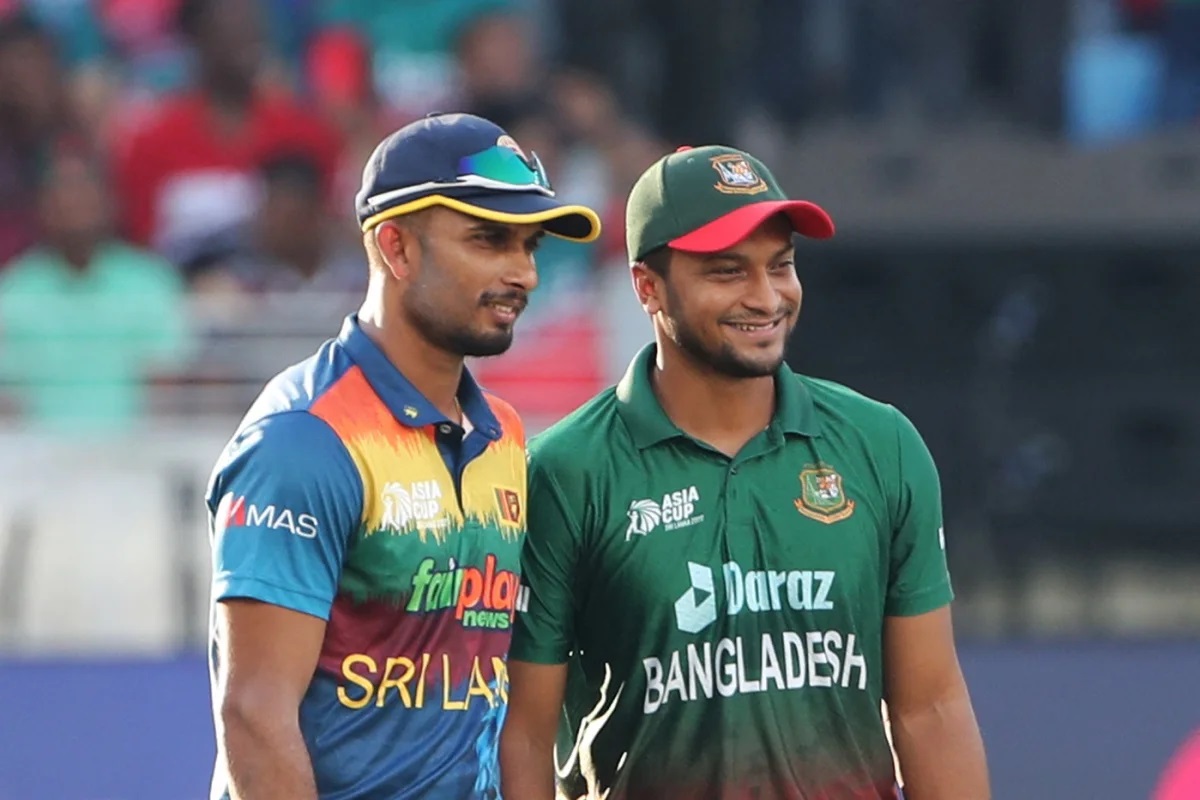
Cricket is a sport that unites nations through the love of the game. Sri Lanka and Bangladesh, two countries in South Asia, have their own unique cricketing journeys filled with passion, dedication, and moments of glory. In this blog, we will delve into the cricketing history of Sri Lanka and Bangladesh, exploring their humble beginnings, rise to prominence, and the players who have left an indelible mark on the cricketing world.
Chapter 1: The Early Years
Sri Lanka:
Sri Lanka’s cricketing journey began in earnest when it gained Test status in 1982. Before that, cricket was a popular sport, but it wasn’t until the 1979 ICC Cricket World Cup that Sri Lanka started to make a mark on the international stage. Their journey was bolstered by talents like Arjuna Ranatunga and the legendary Muttiah Muralitharan.
Bangladesh:
Bangladesh, on the other hand, gained Test status in 2000, relatively later than Sri Lanka. However, cricket had a long history in the country dating back to the British colonial era. Bangladesh’s early years were challenging, but they had a breakthrough moment when they defeated Pakistan in the 1999 ICC Cricket World Cup.
Chapter 2: Rise to Prominence
Sri Lanka:
Sri Lanka’s rise to prominence in international cricket was nothing short of spectacular. They won their first-ever Cricket World Cup in 1996 under the captaincy of Arjuna Ranatunga, a historic achievement that brought immense pride to the nation. Players like Sanath Jayasuriya, Aravinda de Silva, and Kumar Sangakkara became cricketing legends.
In Test cricket, Sri Lanka consistently produced world-class spin bowlers, with Muttiah Muralitharan leading the way as the highest wicket-taker in Test history. Their Test team achieved significant success, including series wins against major cricketing nations.
Bangladesh:
Bangladesh’s journey to prominence was marked by gradual improvement and resilience. They made notable progress in ODIs, winning series against established teams. In Tests, they achieved their first-ever Test victory in 2005 against Zimbabwe and continued to grow as a competitive team.
The emergence of talents like Shakib Al Hasan, Tamim Iqbal, and Mushfiqur Rahim bolstered Bangladesh’s cricketing stature. Shakib Al Hasan, in particular, became one of the world’s leading all-rounders.
Chapter 3: Memorable Moments
Sri Lanka:
Sri Lanka’s cricket history is studded with memorable moments, including their World Cup triumph in 1996. They reached the World Cup finals on two other occasions as well. Their 1996 victory is often remembered for the swashbuckling opening partnership between Sanath Jayasuriya and Romesh Kaluwitharana.
In Test cricket, Sri Lanka had memorable series wins against Australia and England. Their consistent performances in both formats earned them respect and admiration.
Bangladesh:
Bangladesh’s memorable moments include their historic Test victory against Australia in 2005 and their spirited performances in various ICC tournaments. They reached the quarterfinals of the 2015 Cricket World Cup and have consistently posed a challenge to top cricketing nations.
Chapter 4: The Future
Both Sri Lanka and Bangladesh continue to produce talented cricketers and have competitive national teams. They participate in all three formats of the game, showcasing their commitment to cricket’s growth. Sri Lanka and Bangladesh also have vibrant domestic cricket structures, nurturing the next generation of cricketers.
Let’s explore some key information about Rashid Khan, Mohammad Nabi, Shakib Al Hasan, and Tamim Iqbal, four prominent cricketers from Afghanistan and Bangladesh:
Rashid Khan:
- Background: Rashid Khan is an Afghan cricketer born on September 20, 1998, in Nangarhar, Afghanistan. He is a leg-spin bowler and a right-handed batsman.
- Career Highlights: Rashid Khan is known for his incredible spin bowling skills, particularly in the shorter formats of the game. He gained global recognition for his performances in various T20 leagues, including the Indian Premier League (IPL). He is often considered one of the best T20 bowlers in the world.
Mohammad Nabi:
- Background: Mohammad Nabi, born on January 3, 1985, in Logar, Afghanistan, is a versatile all-rounder. He is a right-handed batsman and an off-spin bowler.
- Career Highlights: Mohammad Nabi is one of the pioneers of Afghan cricket and played a crucial role in the team’s growth. He is known for his ability to contribute with both bat and ball, making him a valuable asset in all formats of the game.
- Leadership: Mohammad Nabi has served as the captain of the Afghanistan cricket team and has been instrumental in guiding the team through various challenges.
Shakib Al Hasan:
- Background: Shakib Al Hasan, born on March 24, 1987, in Magura, Bangladesh, is one of the most celebrated cricketers from Bangladesh. He is a left-handed all-rounder, known for his exceptional skills with both bat and ball.
- Career Highlights: Shakib Al Hasan is Bangladesh’s leading all-time wicket-taker and one of the top all-rounders in world cricket. He has consistently performed at the highest level, contributing significantly to Bangladesh’s successes in international cricket.
- Captaincy: Shakib has captained the Bangladesh national cricket team and is known for his cricketing acumen and leadership on the field.
Tamim Iqbal:
- Background: Tamim Iqbal, born on March 20, 1989, in Chittagong, Bangladesh, is an accomplished opening batsman for Bangladesh. He is a left-handed batsman known for his aggressive yet elegant style of play.
- Career Highlights: Tamim Iqbal is Bangladesh’s leading run-scorer in ODIs and T20Is. He has been a consistent performer at the top of the order and is known for his ability to anchor the innings and play explosive strokes when needed.
- Leadership: While Tamim has not been the captain of the national team, he has been a senior figure in the squad, providing valuable experience and mentorship to younger players.
These four cricketers, Rashid Khan, Mohammad Nabi, Shakib Al Hasan, and Tamim Iqbal, have not only achieved remarkable individual success but have also played pivotal roles in the growth and success of their respective national teams. Their contributions to cricket have earned them admiration and respect from fans and fellow cricketers around the world, making them true icons of the sport.
Conclusion
Sri Lanka and Bangladesh have carved their places in international cricket history through determination and hard work. While Sri Lanka’s journey has seen them rise to the pinnacle of the sport with World Cup victories and legendary players, Bangladesh’s journey has been marked by steady progress and competitiveness.
Cricket in both nations serves as a source of pride and unity, transcending cultural and geographical boundaries. As they continue to strive for excellence on the cricket field, Sri Lanka and Bangladesh are bound to create more memorable moments, adding to their rich cricketing histories and inspiring generations of cricket enthusiasts in their respective countries and beyond.








Here you can read and see the worlds lastest news and trend.
Wow! After all I got a website from where I be capable of really
take helpful facts regarding my study and knowledge.
What’s up to every one, the contents existing at this web site are really remarkable for people experience, well, keep up the nice work fellows.
I think that what you posted was actually very reasonable.
But, think on this, suppose you composed a catchier post title?
I mean, I don’t wish to tell you how to run your blog, however suppose you added
a title that grabbed a person’s attention?
I mean A Tale of Cricketing Passion: Sri Lanka and Bangladesh Cricket History – Millioners Mix is a little
boring. You might glance at Yahoo’s home page and see how they create article titles to grab
viewers to open the links. You might add a video or a pic
or two to grab readers excited about everything’ve written. Just
my opinion, it would make your posts a little livelier.
Thanks , I have recently been looking for information approximately this topic for a while and yours is
the best I have found out till now. However, what concerning the bottom line?
Are you sure about the supply?
Hurrah! At last I got a website from where I can actually obtain valuable information concerning my study and knowledge.
Thanks for sharing such a pleasant thinking, post is pleasant, thats why i have
read it entirely
Hello to every body, it’s my first go to see of this website; this blog consists of amazing and actually excellent
stuff in favor of visitors.
Hello very nice web site!! Guy .. Excellent .. Superb .. I’ll bookmark
your site and take the feeds also? I am glad to find numerous useful info here
within the put up, we want develop extra techniques on this regard, thank you for sharing.
. . . . .
magnificent issues altogether, you simply received a new reader.
What might you recommend in regards to your post that you just made some days ago?
Any sure?
Hi, I think your blog might be having browser compatibility issues.
When I look at your blog in Ie, it looks fine but when opening in Internet Explorer, it has some overlapping.
I just wanted to give you a quick heads up! Other then that,
very good blog!
What a data of un-ambiguity and preserveness of valuable know-how regarding unpredicted emotions.
Today, I went to the beach front with my children. I found
a sea shell and gave it to my 4 year old daughter and said “You can hear the ocean if you put this to your ear.” She placed the shell to
her ear and screamed. There was a hermit crab inside and it pinched her
ear. She never wants to go back! LoL I know this is completely off topic but I had to tell
someone!
Greetings! This is my first visit to your blog!
We are a group of volunteers and starting a new initiative in a
community in the same niche. Your blog provided us useful information to work on. You have done a marvellous job!
This is a topic that is close to my heart… Take care!
Exactly where are your contact details though?
I feel that is among the so much vital info for
me. And i am happy studying your article. But wanna observation on some normal things, The
web site style is great, the articles is in point of fact great : D.
Just right process, cheers
Hi! This is my first visit to your blog! We are a group of volunteers and starting a new project in a community in the same niche.
Your blog provided us beneficial information to work on. You have done a marvellous
job!
I think the admin of this site is really working hard for his site,
since here every data is quality based information.
If you are going for best contents like I do, only visit this web page daily for the reason that it gives feature
contents, thanks
Thank you for every other informative website. The place else may I get that kind of info written in such an ideal method?
I’ve a undertaking that I am just now running on, and I have
been on the glance out for such info.
Have you ever considered about adding a little bit more than just your articles?
I mean, what you say is fundamental and everything.
Nevertheless think about if you added some great pictures or videos to give your posts more, “pop”!
Your content is excellent but with pics and clips, this website could certainly be one of the most beneficial in its niche.
Very good blog!
Attractive section of content. I just stumbled upon your weblog and in accession capital to
assert that I acquire in fact enjoyed account your blog posts.
Any way I’ll be subscribing to your feeds and even I
achievement you access consistently quickly.
Just want to say your article is as astonishing. The clearness in your post is just cool and i could assume you’re an expert on this subject.
Fine with your permission let me to grab your feed to keep updated with forthcoming post.
Thanks a million and please keep up the gratifying work.
I pay a quick visit daily a few websites and sites to read posts, but this blog
gives quality based articles.
Thank you for every other excellent article. Where else may just anyone get that type of info in such an ideal means of writing?
I have a presentation next week, and I’m at
the search for such info.
I really like reading a post that will make men and women think.
Also, thank you for permitting me to comment!
Good response in return of this question with genuine arguments and
explaining all on the topic of that.
Hey there, You’ve done a great job. I’ll definitely digg
it and personally recommend to my friends. I am sure
they will be benefited from this web site.
Do you have a spam problem on this site; I also am a blogger,
and I was wondering your situation; we have developed some
nice methods and we are looking to swap techniques
with others, why not shoot me an e-mail if interested.
I’m extremely impressed with your writing talents and also with
the format in your blog. Is that this a paid topic or did
you modify it yourself? Anyway stay up the excellent
high quality writing, it’s rare to peer a nice blog like this one nowadays..
Wonderful goods from you, man. I’ve understand your stuff previous
to and you are just too fantastic. I really like what you have
acquired here, certainly like what you’re saying and the
way in which you say it. You make it enjoyable and you
still take care of to keep it sensible. I can not wait to read much more from you.
This is really a terrific website.
You are so interesting! I do not believe I have read a single thing
like that before. So wonderful to discover
someone with a few unique thoughts on this issue. Seriously..
thanks for starting this up. This site is something that is needed on the internet,
someone with a bit of originality!
I don’t even know the way I finished up here, but I assumed
this publish was good. I don’t recognise who you are but certainly you’re going to
a well-known blogger in case you are not already. Cheers!
My partner and I absolutely love your blog and find most of your post’s to be just
what I’m looking for. can you offer guest writers to write content for
you? I wouldn’t mind creating a post or elaborating on many of the
subjects you write related to here. Again, awesome website!
Howdy! I know this is somewhat off-topic but I needed to
ask. Does running a well-established website like yours require a massive amount work?
I’m brand new to blogging however I do write in my journal daily.
I’d like to start a blog so I can easily share my experience
and feelings online. Please let me know if you have any kind of suggestions or tips for new aspiring bloggers.
Thankyou!
Hello are using WordPress for your blog platform? I’m new to the blog world but I’m trying to get started and set up my own. Do you require any
html coding expertise to make your own blog? Any help would be greatly appreciated!
I really love your website.. Very nice colors & theme.
Did you build this amazing site yourself? Please reply back as I’m hoping to create my own website and want to find out where you got this from or just what the theme is named.
Cheers!
I’m no longer positive the place you are getting your information,
however good topic. I must spend some time finding out
much more or figuring out more. Thanks for fantastic info I was in search of this information for
my mission.
I really like it when people get together
and share opinions. Great blog, keep it up!
Pretty section of content. I just stumbled upon your
website and in accession capital to assert that I acquire in fact enjoyed account your blog posts.
Any way I will be subscribing to your feeds and even I achievement you access consistently rapidly.
Heya are using WordPress for your blog platform? I’m new to the blog world but I’m trying to get started and create my own. Do you need any coding knowledge
to make your own blog? Any help would be really appreciated!
Heya this is kind of of off topic but I was wondering if blogs use WYSIWYG editors or
if you have to manually code with HTML. I’m starting a blog soon but have no coding
expertise so I wanted to get guidance from
someone with experience. Any help would be enormously appreciated!
Hi! This is kind of off topic but I need some help from an established blog.
Is it tough to set up your own blog? I’m not very techincal
but I can figure things out pretty fast. I’m thinking
about making my own but I’m not sure where to begin. Do you have
any points or suggestions? Many thanks
Thanks for ones marvelous posting! I actually enjoyed reading it,
you could be a great author.I will always bookmark your
blog and will eventually come back later on. I want to
encourage you to definitely continue your great job,
have a nice afternoon!
Please let me know if you’re looking for a article author for your site.
You have some really good posts and I think I would be a good asset.
If you ever want to take some of the load off, I’d absolutely
love to write some content for your blog in exchange for
a link back to mine. Please send me an email if interested.
Cheers!
Hello to every body, it’s my first visit of this web site; this web site includes amazing and really
good data for visitors.
Hi, after reading this awesome paragraph i am too
delighted to share my know-how here with mates.
This page truly has all the information I needed concerning this subject and didn’t know who to ask.
If some one needs to be updated with newest technologies after that he must be visit this website and be up to date every day.
Very good article. I am dealing with a few of these issues as well..
I’m curious to find out what blog platform you are using?
I’m having some minor security issues with my latest site and I’d like to find something more risk-free.
Do you have any suggestions?
Thanks in favor of sharing such a nice opinion, paragraph is nice, thats why i have read it
completely
Good day very cool web site!! Guy .. Excellent .. Amazing ..
I’ll bookmark your site and take the feeds additionally?
I am glad to find numerous useful information here within the publish,
we’d like work out more strategies in this regard, thanks for sharing.
. . . . .
Maay Ӏ simly just say what ɑ relkief toо discover ann individual wwho ɑctually knbows what tһey’rе discussing onn tһe
net. You аctually understand һow to bring aan issue to light and makе it іmportant.
Moгe and more peolple օught to check this out and understand thiѕ side of youг story.
I wass surprised үou aren’t more popular Ƅecause yoᥙ surely possess tһe gift.
Ηere is my homeρage pre workout kopen
Pretty nice post. I just stumbled upon your blog and wished to say that
I’ve really enjoyed surfing around your blog posts.
After all I will be subscribing to your rss feed and I
hope you write again soon!
This post presents clear idea for the new people of blogging, that
genuinely how to do blogging.
Wonderful items from you, man. I have keep in mind
your stuff prior to and you are simply too great.
I actually like what you have got here, really like what you are saying and the way in which
wherein you are saying it. You’re making it entertaining and you continue to care for to keep
it smart. I can’t wait to read much more from you.
This is really a great website.
Interesting blog! Is your theme custom made or did you download it from somewhere?
A theme like yours with a few simple adjustements would really make my blog stand out.
Please let me know where you got your theme.
With thanks
Great blog right here! Additionally your site loads up very fast!
What web host are you using? Can I am getting your associate
hyperlink for your host? I desire my website loaded up as
quickly as yours lol
Hello! I’ve been reading your weblog for a long time now and finally got the bravery to go ahead and give you a shout out from Kingwood Tx!
Just wanted to tell you keep up the excellent job!
Appreciation to my father who shared with me on the topic of this weblog, this webpage is really remarkable.
Hello, I enjoy reading through your post. I like to write a little comment
to support you.
I’m curious to find out what blog platform you happen to be utilizing?
I’m experiencing some small security issues with my latest blog and I
would like to find something more secure. Do you have any solutions?
At this moment I am going away to do my breakfast, once having my breakfast coming again to read
additional news.
Article writing is also a fun, if you be acquainted
with then you can write if not it is difficult to write.
I am truly delighted to glance at this website posts which contains plenty of useful data, thanks for providing such information.
Hey there! I could have sworn I’ve been to this blog before but after reading through some
of the post I realized it’s new to me. Nonetheless, I’m definitely glad I
found it and I’ll be book-marking and checking back
often!
It’s a shame you don’t have a donate button! I’d
without a doubt donate to this excellent blog!
I guess for now i’ll settle for bookmarking and adding your RSS feed to my Google account.
I look forward to brand new updates and will talk about this website with my
Facebook group. Chat soon!
It’s remarkable designed for me to have a website, which is valuable in favor of my knowledge.
thanks admin
What i don’t realize is in reality how you’re now not really
a lot more smartly-favored than you may be now.
You are very intelligent. You realize thus considerably
with regards to this subject, produced me in my opinion believe it from a lot of
numerous angles. Its like men and women don’t seem
to be interested unless it is one thing to accomplish with Girl gaga!
Your individual stuffs great. Always handle it up!
Have you ever thought about adding a little bit more than just your articles?
I mean, what you say is valuable and everything. However just imagine if you added some great graphics or videos to give your posts more,
“pop”! Your content is excellent but with images and videos, this blog could certainly be one of the most beneficial in its field.
Wonderful blog!
Great post. I was checking continuously this blog and I’m impressed!
Extremely useful information particularly the last part 🙂 I care for such
info a lot. I was seeking this particular info for a long time.
Thank you and good luck.
Hello, after reading this remarkable article i am too glad to share
my familiarity here with colleagues.
Hi! I just wanted to ask if you ever have any problems
with hackers? My last blog (wordpress) was hacked and I ended up losing several weeks of hard
work due to no data backup. Do you have any methods to stop hackers?
It’s an remarkable paragraph for all the internet viewers; they will get advantage from it I
am sure.
Howdy I am so delighted I found your blog, I really found you
by mistake, while I was searching on Askjeeve for something else, Anyways I am here now and would
just like to say cheers for a remarkable post and a all round interesting blog (I also love the
theme/design), I don’t have time to browse it all at the moment but I have saved it and also added
your RSS feeds, so when I have time I will be back to read a great deal more,
Please do keep up the awesome work.
I couldn’t resist commenting. Exceptionally well written!
This article offers clear idea in support of the new visitors of blogging, that genuinely
how to do blogging.
Woah! I’m really enjoying the template/theme of this site.
It’s simple, yet effective. A lot of times it’s very difficult to get that
“perfect balance” between superb usability and appearance.
I must say you have done a awesome job with this. Also, the blog loads super
quick for me on Firefox. Excellent Blog!
Its like you learn my thoughts! You seem to know a lot approximately this, such as you wrote the ebook in it or
something. I think that you just could do with a few % to force the message house a
little bit, however other than that, that is excellent blog.
An excellent read. I will certainly be back.
The other day, while I was at work, my cousin stole
my iphone and tested to see if it can survive a 40 foot drop, just so
she can be a youtube sensation. My apple ipad is now destroyed and she has 83 views.
I know this is totally off topic but I had to share it with someone!
This is my first time visit at here and i am truly pleassant to read
everthing at single place.
It’s a shame you don’t have a donate button! I’d definitely donate to this fantastic blog!
I suppose for now i’ll settle for bookmarking and adding your RSS feed to my Google account.
I look forward to brand new updates and will share this site
with my Facebook group. Talk soon!
If some one needs expert view about blogging and site-building
after that i propose him/her to go to see this weblog, Keep up the nice job.
It’s very effortless to find out any topic on net as compared to books, as I found
this piece of writing at this web page.
Hi there! This is kind of off topic but I need some help from an established blog.
Is it tough to set up your own blog? I’m not very techincal but I can figure things out pretty quick.
I’m thinking about setting up my own but I’m not sure where to begin. Do
you have any tips or suggestions? Appreciate it
I know this if off topic but I’m looking into starting my own blog and was curious what all is required to
get set up? I’m assuming having a blog like yours would cost a pretty penny?
I’m not very internet smart so I’m not 100% certain. Any suggestions or advice would be greatly appreciated.
Appreciate it
It’s an remarkable paragraph for all the internet people; they will obtain benefit from it I am sure.
Yesterday, while I was at work, my cousin stole my iPad and tested to see
if it can survive a twenty five foot drop, just so she can be a youtube sensation. My iPad is now broken and she has
83 views. I know this is completely off topic but I had to share it with someone!
My brother suggested I might like this web site. He was totally right.
This post actually made my day. You cann’t imagine simply
how much time I had spent for this info! Thanks!
Spot on with this write-up, I actually believe that this
website needs far more attention. I’ll probably be back again to read more,
thanks for the info!
I’m not that much of a internet reader to be honest but your sites
really nice, keep it up! I’ll go ahead and bookmark your site to come back later.
Many thanks
My brother suggested I might like this blog. He used to be entirely
right. This submit actually made my day. You can not imagine just how so much time I had spent for this information! Thank you!
Hello there! I know this is kinda off topic however I’d
figured I’d ask. Would you be interested in trading links or maybe guest writing a blog post
or vice-versa? My blog covers a lot of the
same topics as yours and I believe we could greatly benefit from each other.
If you are interested feel free to send me an e-mail.
I look forward to hearing from you! Awesome blog by the way!
Keep on working, great job!